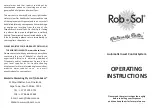
Oscilloscope Block Diagram and Theory of Operation
A
4000 X-Series Oscilloscopes Advanced Training Guide
153
To obtain the highest resolution and accurate measurements, the input to the ADC
must be scaled within its dynamic range, which is ± V. Although the ADC has a
limited and fixed input dynamic range based on the ADC’s reference voltages
(± V), scopes must be able to capture a broad dynamic range of signals including
both high level and low level input signals. Scaling the ADCs analog input to be
within the ADC’s dynamic range is the combined function of the attenuator, DC
offset, and amplifier blocks, which are discussed next.
Attenuator Block
The attenuator block is basically a network of resistor dividers used to scale the
input signal to be within the dynamic range of the scope’s variable gain analog
amplifier and ADC. When inputting a high level input signal such as 40 Vpp, the
signal level must be reduced (attenuated). If inputting a low level input signal such
as 10 mVpp, then the input signal is passed through to the amplifier with no
attenuation (1:1). When you change the scope’s V/div setting, you may hear
audible clicking sounds. The clicking that you hear are mechanical relays
switching-in different resistor divider networks. Note that the attenuator block
also includes switching of the user-selectable input impedance (1 M
Ω
or 50
Ω
), as
well as AC or DC input coupling.
DC Offset Block
When inputting a signal with DC offset such as a digital signal that swings
between 0V to 5V, if we want to display this signal centered on the scope’s display,
then an internal DC offset of the opposite polarity must to added to the signal in
order to shift the input signal to be within the ADC’s dynamic range. Alternatively,
AC coupling can be selected to eliminate the DC component of the input signal.
Amplifier Block
The final analog processing stage to scale the input signal to be within the
dynamic range of the ADC system is the scope’s variable gain amplifier. If inputting
a very low level input signal, you would typically set the V/div setting to a relatively
low setting. With a low V/div setting the attenuator stage would then pass this
signal straight through to the amplifier with no attenuation (gain =1), and then the
amplifier would boost (gain >1) the amplitude the signal in order to take
advantage of the full dynamic range of the ADC. If inputting a very high level input
signal, you would typically set the V/div setting to a relatively high setting. Using a
high V/div setting, the attenuator stage would first attenuate the input signal (gain
< 1) to get it within the dynamic range of the amplifier, and then the amplifier may
further attenuate the signal (gain <1) to get it within the dynamic range of the
ADC.
Содержание 4000 X-Series
Страница 12: ...12 4000 X Series Oscilloscopes Advanced Training Guide 1 Getting Started...
Страница 156: ...156 4000 X Series Oscilloscopes Advanced Training Guide A Oscilloscope Block Diagram and Theory of Operation...
Страница 166: ...166 4000 X Series Oscilloscopes Advanced Training Guide B Oscilloscope Bandwidth Tutorial...
Страница 168: ...168 4000 X Series Oscilloscopes Advanced Training Guide C Related Keysight Literature...
















































